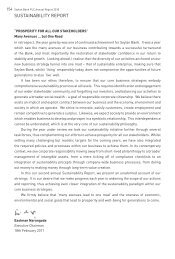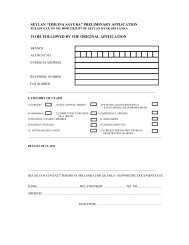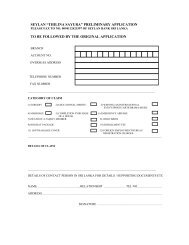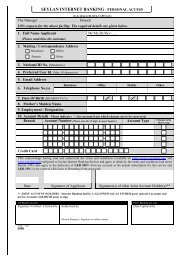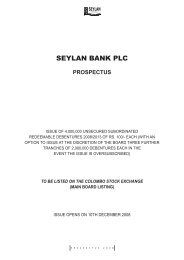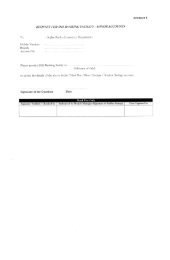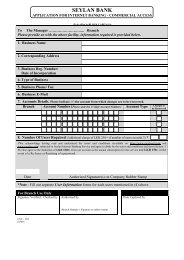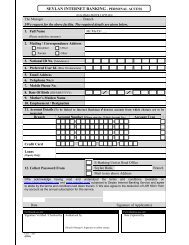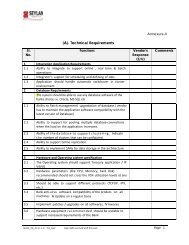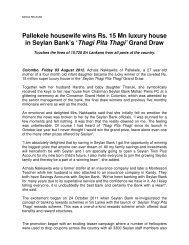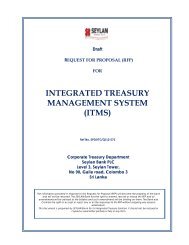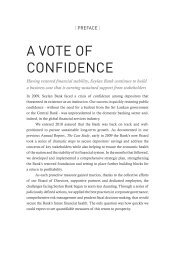The Case Study - Seylan Bank
The Case Study - Seylan Bank
The Case Study - Seylan Bank
You also want an ePaper? Increase the reach of your titles
YUMPU automatically turns print PDFs into web optimized ePapers that Google loves.
156<strong>Seylan</strong> <strong>Bank</strong> PLC Annual Report 2009Notes to the Consolidated Financial Statements1.4.28 VAT on Financial Services<strong>The</strong> value base for value added tax for the <strong>Bank</strong> is the adjusted accounting profit before tax and emolumentsof employees. <strong>The</strong> adjustment to the accounting profit before tax is for economic depreciation computed onprescribed rates instead of the rates adopted in the Financial Statements.1.4.29 Fee and Commission IncomeAll fee and commission income have been recorded when a trade takes place.1.4.30 Profit or Loss on Sale of Property, Plant & Equipment/InvestmentsGains or losses of a revenue nature on the disposal of Property, Plant & Equipment and share portfolio areaccounted for in the Income Statement.1.4.31 Interest ExpensesInterest payable is recognised on an accrual basis. Other expenses have been recognised in the accounts asthey are incurred in the period to which they relate.1.4.32 Earnings Per Share<strong>The</strong> Group presents basic Earnings Per Share (EPS) data for its ordinary shares. Basic EPS is calculated bydividing the profit or loss attributable to ordinary shareholders of the <strong>Bank</strong> by the weighted average numberof ordinary shares outstanding during the period.1.4.33 Segment ReportingA segment is a distinguishable component of the Group that is engaged either in providing related products orservices (business segment), or in providing products and services within a particular economic environment(geographical segment), which is subject to risks and returns different from those of other business segments.For the purposes of segment reporting disclosures, the information is presented in respect of the Group’sbusiness segments, which is based on the Group’s management and internal reporting structure. <strong>The</strong> Groupcomprises the following major business segments: <strong>Bank</strong>ing, Leasing, Treasury and Property/Investments.Inter-segment pricing is determined on an arm’s-length basis.Measurement of segment assets, liabilities, segment revenue and results is based on the accountingpolicies set out above. Segment revenue results, assets and liabilities include items directly attributable tosegments as well as those that can be allocated on a reasonable basis.Disclosure by geographical region is not provided for as the Group’s activities are located in Sri Lanka andthe economic environment in which the Group operates is not subject to risk and return that are significantlydifferent on a geographical basis.1.4.34 Cash Flow<strong>The</strong> cash flow has been prepared using the direct method of preparing cash flows in accordance with theSri Lanka Accounting Standard 9 - ‘Cash Flow Statements’.For the purpose of the Cash Flow Statement, cash and cash equivalents include notes and coins on hand,unrestricted balances held with the Central <strong>Bank</strong> and highly liquid financial assets with original maturitiesof less than three months, which are subject to insignificant risk of changes in their value and are used bythe Group in the management of its short-term commitments.1.4.35 Financial Risk Management(a) Introduction and Overview<strong>Bank</strong> has implemented a risk management framework in order to identify, measure, mitigate and controlthe various risk falling within market credit and operational risk.



